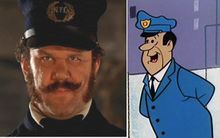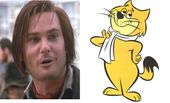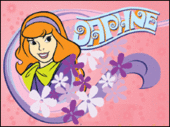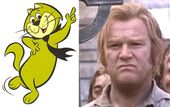Gangs of New York
Martin Scorsese’s 2002 epic, Gangs of New York won 10 Oscars and was nominated for over a thousand. But few people realise that his was not an entirely original concept.
Back in 1969 William Hanna and Joseph Barbera were looking to expand their animation empire away from 10 minute cartoons and into more serious territory. They selected two of their most popular groups of characters to star in their most ambitious project to date, a three hour investigation of the meaning of loyalty within the confines of criminality, the need for vengeance and the impact of mass-immigration on the indigenous working class. The Scooby Doo gang were chosen to represent the dogged determination of native New Yorkers, while Top Cat and his crew’s ability dwell in alleyways and subside on stolen construction workers’ lunch-pails cast them as the newly arrived underclass.
The film was never released due to censors’ concerns about the effect of the level of violence on younger children and Shaggy’s demand for 2% of the gross. It became one of the great lost films of all time and, despite Scorsese denying having seen the HB version, a brief summary of the plot shows just how closely his movie echoes its predecessor.
Many people hailed the Oscar-winning performance of Daniel Day-Lewis as Bill "the Butcher" Cuttings, but alongside Freddie’s portrayal of The Fop, it seems both self-indulgent and two dimensional. Likewise, Leonardo DiCaprio added knife twirling to his usual range of cuteness and boyish appeal but could not match Brain for depth of character or the intensity of his repressed rage. Faced with the inability of his leading men to match up to Freddie or Brain, Scorsese seems to have been able to counter only with extravagant facial hair. Just how many Oscars Hanna Barbera may have won in more enlightened times we can only speculate.
Plot
The Prologue
It is 1846 and the territorial war which has raged around Manhattan’s Five Points district is about to come to a head. Leading the locally-born “Natives” is charismatic Freddie “The Fop”, his tight white sweater and orange cravat marking him out as as somehow different from the others, his determination to gain the overall control of the city undimmed by the endless bloodshed. Central to Native beliefs is a pathological hatred of recent immigrant felines, who have formed their own gang in response, “The Dead Pussies”. Leading the defence is Priest Vallon, known to all as the Top Cat – and, to his close friends, as TC.
In a climactic and bloody battle in Paradise Square, Vallon is killed by the Fop – a murder witnessed by his son, Rotterdam. As the Top Cat breathes his last on the bloodied snow he forces his son to confront their bitter reality.
"Never look away," he rasps, as Rotterdam tries to avert his gaze from the gore.
In a moment of pure theatre the young Rotterdam looks back one last time at his dying father.
"Duh, okay, Pops. Are we going for ice cream now?"
The Fop declares the Dead Pussies outlawed and orders that Vallon be buried with honour, his grave covered with concrete to stop feral dogs digging up the corpse. Rotterdam, meanwhile, takes the knife that killed his father and removes his tail for use as a duster. He buries the razor in wasteland, carefully spraying the area to scent-mark it so that he may later return. Then, seemingly numb, he wanders the streets of New York.
Eventually, hungry and cold, he is spotted by Velma Dinkley who scours the winter streets of the city in high-visibility, day-glo orange sweaters picking up waifs, strays and butch girls. She reaches Rotterdam just as he is climbing into a sack and preparing to drown himself in the icy East River. Unable to have children of her own due to repressive nineteenth century, anti-lesbian adoption laws, Velma has founded St. Jinkies Orphanage for Meddling Kids and takes Rotterdam back to what will become his first real home.
The Return
Sixteen years later Rotterdam returns to New York, no longer a kitten. It is September 1862, the second year of the American Civil War – a dispute in which the Northern states are attempting to convince their southern counterparts to free their slaves by the compelling force of moral argument and the enthusiastic application of high explosives and cavalry charges.
Rotterdam harbours a burning desire for vengeance and an intellect honed for years under the tutelage of Velma (until she lost her glasses). As a consequence he now goes by the name of “Brain”, and is especially skilled at spotting clues and recognising that monsters are quite likely to be local hotel owners in disguise. It is here that we first realise that Scorsese's remake fails to improve on the original. Leonardo Di Caprio is the master of looking straight into the camera and appealing to the mother in all women and equally adept at looking sideways into the camera and appealing to the mother in all women. But it is clear from his first scene that he will never match the ferocity of internalised fury that bubbles beneath the orange fur of Brain.
As he begins a new life in the city, Brain begins to "fit the pieces together" in the way Velma has taught him. He recognises that far from being friendless, the city is full of potential allies. First amongst these is career criminal Johnny Sirocco, who is none other than his father’s friend Fancy-Fancy behind a latex mask. Fancy now runs a clan of pickpockets,
as well as haunting the dockside in a fluorescent diver’s costume in the hope of scaring off intruders until he can locate a cache of pirate’s treasure.
Fancy introduces Brain to Freddie the Fop for whom he now works. As Brain insinuates himself into the Fop’s network he discovers many more of his father’s old acquaintances, including Happy Jack Dibble, a corrupt city constable in Freddie’s pay. Also in the gang he finds Shaggy McGloin, one of the Fop’s most trusted lieutenants, who leads the city in saluting the victory over the Dead Pussies by publicly creating giant, multi-layered cat sandwiches and attempting to eat them before his Great Dane. Again we see Scorsese playing catch-up with Hanna Barbera's inspired casting: where Daniel Day-Lewis is self-indugent and histrionic, Freddie oozes evil and honour in equal parts; where Gary Lewis' McGloin is seedy and unattractive, Shaggy is both hungry and terrified.
The Love Interest
In time Brain meets Daphne Everdean, a pickpocket and prostitute. He is instantly attracted to her, partly due to her taste in purple mini-dresses and partly because of her generosity with Scooby Snacks. He discovers that Daphne was once The Fop’s ward and uses her to gain his confidence. Soon, Freddie has become Brain’s mentor and Brain begins to consider a plan for revenge.
At the same time, Brain becomes involved in the semi-criminal empire of Boss Benny "The Ball" Tweed, the corrupt leader of Tammany Hall which now controls the city. Together they organise a series of Negro lynchings to protest against the proclamation of emancipation and as a way to bring all sections of the city together in a common interest.
Once again, casting leaves Scorsese's version trailing the 1969 classic. Every line of Daphne's figure screams sex at the viewer. By comparisson Cameron Diaz is a mere bottle blonde unable to command a scene without sperm in her hair. An honourable mention should be made, however, for Jim Broadbent's Boss Tweed who stands shoulder to shoulder with Boss Benny the Ball for natural authority and gravitas though ultimately cannot match Benny's inherent menace.
Brain foils an assassination attempt on the Fop during a boozy night at Hooters. The following day he is racked with remorse as he realises that he acted from genuine devotion to Freddie rather than to see out his own vengeance plans. In his anguish Brain attempts to explain his conflicting emotions to Daphne while she nurses the injured Fop. A touching scene follows in which DiCaprio fails to match Brain for pathos; the young hero struggles to find the words to describe his emotions. Eventually, after several false starts, he utters the stirring line:
“Duh, hiya purple lady”.
The two make love in the back-yard, yowling their passion to the moon and dodging shoes hurled by angry neighbours. Later Brain awakes to find Freddie sitting next to his bed wearing nothing but the Stars and Stripes and a leather codpiece. In a long, rambling speech Freddie expounds on the fall of civilisation, the regrettable need for violence and how he has never felt any physical attraction to another male before meeting Brain.
Jealous of Brain’s closeness with The Fop and his relationship with Daphne, Johnny Sirroco seeks out Freddie and reveals Brain's plans to kill him. Freddie lures Daphne to a meeting and abducts her. He baits Brain into revealing himself by staging a knife-throwing act with Daphne. Brain attempts to fight back by throwing his own knife at Freddie, but had long been denied access to sharp objects at the orphanage and instead stabs himself in the foot.
"I took the father, now I'll take the son." Freddie declares.
In an instant, The Fop impales Brain with his own penis, repeating the act to the applause of a packed crowd. He declares that forcing Brain to live a life of shame is worse than death.
“You’ll be a freak,” he declares. “Worthy of Elton John’s harem of big, butch boys.”
He then attempts to place an indelible mark of shame on Brain’s face with his own semen.
On the Run
Brain and Daphne go into hiding while she nurses him back to health. She plans to escape to San Fransisco but Brain is reluctant to go to a city where he thinks the shame of his homosexual experience will be held against him. Even the previously infallible “Would you do it for a Scooby Snack?” line fails to make an impact.
The two are visited by Spook McGinn, a barber’s rat-catcher and former mercenary for Top Cat. He gives Brain his father’s straight razor and a ball of twine infused with cat-nip to amuse himself during his convalescence.
Eventually, Brain announces his return and Freddie and Dibble assemble a posse to search for him. Freddie suggests splitting-up, with him and Dibble going one way while Shaggy McGloin and his Great Dane investigate the crypt of a creepy old church. Brain narrowly avoids capture in a chase through the catacombs by pretending to be a make-up artiste and doing Shaggy’s face. Later he wears a sheet which convinces Shaggy that he is a ghost. The catacombs echo to the sound of “Like, Zoinks!" and "Gangway!!!!” as Shaggy and his dog run away, pausing only to set nets for the "ghost" which they later run straight into.
In perhaps the most heart-rending scene of the entire movie, the camera pulls back to show the pair now suspended above separate vats of acid, each containing strangely happy sharks. The Great Dane looks across to his partner one last time.
“Raggy! Relp!” he cries. But for once Shaggy can be no help and Brain finishes off them both, leaving the corpses on the Fop's door-step overnight.
The Beginning of the End
A plot is hatched in which Brain uses his influence and the power of his oratory to have Benny the Ball elected mayor. In return Benny promises to support Spook's candidature as Sheriff against the Fop’s nominee. On election day both sides compel their supporters to turn out to the polling stations but Spook wins by more votes than there are voters. Freddie challenges Spook, who suggests that hanging chads may be to blame, prompting Freddie to resort to a mammoth three day recount and a meat-cleaver in Spook’s back in true Republican manner.
At the subsequent funeral, Brain issues his own challenge. But, as he and Freddie are about to engage their gangs in a final battle, the New York Draft riots erupt and many gang-members depart to tar and feather freed slaves. When the gangs meet up again in Paradise Square, the Navy shell them, mistaking them for the Japanese. Soldiers finish off many of the remaining gangsters but Freddie and Brain fight their own private battle until another blast fills the square with dust and debris. As the dust settles Brain discovers that Freddie has been impaled on the sharp, starched corners of his own cravat.
“I thank God I die a true faggot,” he gasps, as Brain applies the coup de grace with carefully manicured retractable claws.
The Epilogue
The dead are collected. Freddie is buried in view of the Manhattan skyline, next to TC’s grave. The city slowly begins to return to normality. Daphne and Brain visit to bury his father’s razor (again).
Even in the final moments of the two films it is clear that Scorsese cannot hold a candle to the genius of Hanna and Barbera. The 2002 version plays on simple emotions of regret and patriotism by showing images of the current Manhattan skyline and the Twin Towers as the young lovers discuss the likelihood of their doings being forgotten as New York continues to grow and prosper in the coming centuries. The 1969 original, however, shows them outside a spooky old house with bats flying from the windows and a fog-horn sounding as an eerie paddle-steamer passes along the Hudson. Scorsese's simplicity seems cheap, almost tawdry beside the far subtler imagery of Hanna and Barbera; the spooky house representing America's uncertain future as the Civil War draws to an end, the bats the madness of all war, the paddle-steamer the role of immigration to the blossoming of the USA in the coming century and the foghorn a metaphor for the need to alert shipping to mobile dangers in limited visibility.
As the credits roll the couple look down once more at the grave of Brain's long dead father and pause over Freddie’s tombstone to deliver the closing line:
“He'd have gotten away with it too if it hadn't been for meddling with kids.”
Other lost classics
It is to be hoped that renewed interest in Hanna Barbera's Gangs of New York will persuade HB to release other unseen masterpieces of animation such as Secret Squirrel's Casino Royale, Hong Kong Phooey: Enter the Dachshund, Days of Thunder: The Wacky Races Years and Dynomutt Does Dallas.










